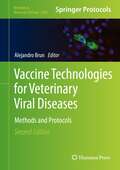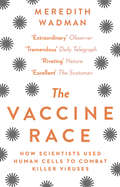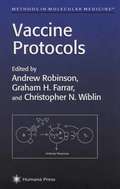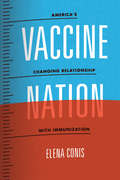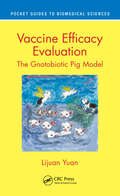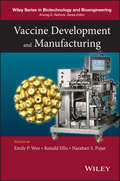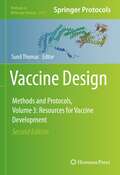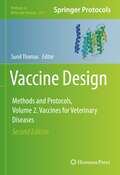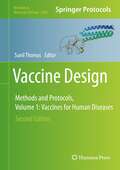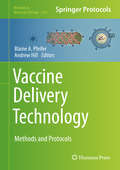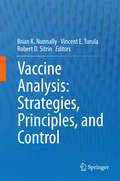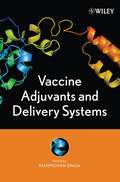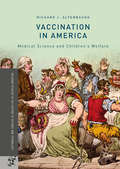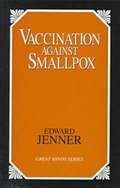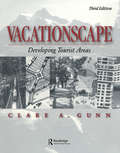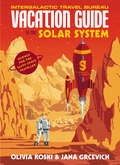- Table View
- List View
Vaccine Technologies for Veterinary Viral Diseases: Methods and Protocols (Methods in Molecular Biology #2465)
by Alejandro BrunThis second edition includes a collection of antigen production and delivery strategies for vaccine development in veterinary species. New and updated chapters guide readers through protocols for antigen production, experimental antigen delivery and the analysis of immune responses upon vaccination. Written in the format of the highly successful Methods in Molecular Biology series, each chapter includes an introduction to the topic, lists necessary materials and reagents, includes tips on troubleshooting and known pitfalls, and step-by-step, readily reproducible protocols. Authoritative and cutting-edge, Vaccine Technologies for Veterinary Viral Diseases: Methods and Protocols, Second Edition aims to be a useful and practical guide to researches to help further their study in this field.
The Vaccine Race: How Scientists Used Human Cells to Combat Killer Viruses
by Meredith Wadman**SHORTLISTED FOR THE WELLCOME BOOK PRIZE 2018 **** A GUARDIAN SCIENCE BOOK OF THE YEAR 2017 **‘Riveting … invites comparison to Rebecca Skloot's The Immortal Life of Henrietta Lacks’NatureThe epic and controversial story of a major breakthrough in cell biology that led to the conquest of rubella and other devastating diseases.Until the late 1960s, tens of thousands of children suffered crippling birth defects if their mothers had been exposed to rubella, popularly known as German measles, while pregnant. There was no vaccine and little understanding of how the disease devastated foetuses. In June 1962, a young biologist in Philadelphia produced the first safe, clean cells that made possible the mass-production of vaccines against many common childhood diseases. Two years later, in the midst of a German measles epidemic, his colleague developed the vaccine that would one day effectively wipe out rubella for good. This vaccine - and others made with those cells - have since protected hundreds of millions of people worldwide, the vast majority of them preschool children. Meredith Wadman’s account of this great leap forward in medicine is a fascinating and revelatory read.
Vaccine Protocols (Methods in Molecular Medicine #4)
by Andrew Robinson, Graham H. Farrar and Christopher N. WiblinThe production of a book devoted to Vaccine Protocols has proved to be a complex task; the variety of procedures required to design, develop, pro duce, and assess a vaccine is immense and covers aspects of chemistry, bio chemistry, molecular biology, and immunology. Many of the previous volumes in the Methods in Molecular Biology series provide the background required for work on vaccines; of particular interest are the volumes on Immunochemi cal Protocols, Practical Molecular Virology, Proteins, and Nucleic Acids. In the volume on Vaccine Protocols, we have tried to cover the latest scientific methods for the design, production, and assessment of vaccines against viruses, bacteria, and parasites. Essentially, the volume is comprised of three basic chapter types. First, a number of chapters describe in detail the development and production of vac cines by specific techniques, including genetic manipulation of viruses or bac teria to produce live attenuated vaccines or inactivated toxins, and the production of synthetic peptides and conjugate vaccines. Second, a similar number of chapters describe more general techniques that can be used for the formulation, delivery, and assessment of immune responses to vaccines.
Vaccine Nation: America's Changing Relationship with Immunization
by Elena ConisWith employers offering free flu shots and pharmacies expanding into one-stop shops to prevent everything from shingles to tetanus, vaccines are ubiquitous in contemporary life. The past fifty years have witnessed an enormous upsurge in vaccines and immunization in the United States: American children now receive more vaccines than any previous generation, and laws requiring their immunization against a litany of diseases are standard. Yet, while vaccination rates have soared and cases of preventable infections have plummeted, an increasingly vocal cross section of Americans have questioned the safety and necessity of vaccines. In Vaccine Nation, Elena Conis explores this complicated history and its consequences for personal and public health. Vaccine Nation opens in the 1960s, when government scientists—triumphant following successes combating polio and smallpox—considered how the country might deploy new vaccines against what they called the “milder” diseases, including measles, mumps, and rubella. In the years that followed, Conis reveals, vaccines fundamentally changed how medical professionals, policy administrators, and ordinary Americans came to perceive the diseases they were designed to prevent. She brings this history up to the present with an insightful look at the past decade’s controversy over the implementation of the Gardasil vaccine for HPV, which sparked extensive debate because of its focus on adolescent girls and young women. Through this and other examples, Conis demonstrates how the acceptance of vaccines and vaccination policies has been as contingent on political and social concerns as on scientific findings. By setting the complex story of American vaccination within the country’s broader history, Vaccine Nation goes beyond the simple story of the triumph of science over disease and provides a new and perceptive account of the role of politics and social forces in medicine.
Vaccine Nation: America's Changing Relationship with Immunization
by Elena ConisWith employers offering free flu shots and pharmacies expanding into one-stop shops to prevent everything from shingles to tetanus, vaccines are ubiquitous in contemporary life. The past fifty years have witnessed an enormous upsurge in vaccines and immunization in the United States: American children now receive more vaccines than any previous generation, and laws requiring their immunization against a litany of diseases are standard. Yet, while vaccination rates have soared and cases of preventable infections have plummeted, an increasingly vocal cross section of Americans have questioned the safety and necessity of vaccines. In Vaccine Nation, Elena Conis explores this complicated history and its consequences for personal and public health. Vaccine Nation opens in the 1960s, when government scientists—triumphant following successes combating polio and smallpox—considered how the country might deploy new vaccines against what they called the “milder” diseases, including measles, mumps, and rubella. In the years that followed, Conis reveals, vaccines fundamentally changed how medical professionals, policy administrators, and ordinary Americans came to perceive the diseases they were designed to prevent. She brings this history up to the present with an insightful look at the past decade’s controversy over the implementation of the Gardasil vaccine for HPV, which sparked extensive debate because of its focus on adolescent girls and young women. Through this and other examples, Conis demonstrates how the acceptance of vaccines and vaccination policies has been as contingent on political and social concerns as on scientific findings. By setting the complex story of American vaccination within the country’s broader history, Vaccine Nation goes beyond the simple story of the triumph of science over disease and provides a new and perceptive account of the role of politics and social forces in medicine.
Vaccine Nation: America's Changing Relationship with Immunization
by Elena ConisWith employers offering free flu shots and pharmacies expanding into one-stop shops to prevent everything from shingles to tetanus, vaccines are ubiquitous in contemporary life. The past fifty years have witnessed an enormous upsurge in vaccines and immunization in the United States: American children now receive more vaccines than any previous generation, and laws requiring their immunization against a litany of diseases are standard. Yet, while vaccination rates have soared and cases of preventable infections have plummeted, an increasingly vocal cross section of Americans have questioned the safety and necessity of vaccines. In Vaccine Nation, Elena Conis explores this complicated history and its consequences for personal and public health. Vaccine Nation opens in the 1960s, when government scientists—triumphant following successes combating polio and smallpox—considered how the country might deploy new vaccines against what they called the “milder” diseases, including measles, mumps, and rubella. In the years that followed, Conis reveals, vaccines fundamentally changed how medical professionals, policy administrators, and ordinary Americans came to perceive the diseases they were designed to prevent. She brings this history up to the present with an insightful look at the past decade’s controversy over the implementation of the Gardasil vaccine for HPV, which sparked extensive debate because of its focus on adolescent girls and young women. Through this and other examples, Conis demonstrates how the acceptance of vaccines and vaccination policies has been as contingent on political and social concerns as on scientific findings. By setting the complex story of American vaccination within the country’s broader history, Vaccine Nation goes beyond the simple story of the triumph of science over disease and provides a new and perceptive account of the role of politics and social forces in medicine.
Vaccine Nation: America's Changing Relationship with Immunization
by Elena ConisWith employers offering free flu shots and pharmacies expanding into one-stop shops to prevent everything from shingles to tetanus, vaccines are ubiquitous in contemporary life. The past fifty years have witnessed an enormous upsurge in vaccines and immunization in the United States: American children now receive more vaccines than any previous generation, and laws requiring their immunization against a litany of diseases are standard. Yet, while vaccination rates have soared and cases of preventable infections have plummeted, an increasingly vocal cross section of Americans have questioned the safety and necessity of vaccines. In Vaccine Nation, Elena Conis explores this complicated history and its consequences for personal and public health. Vaccine Nation opens in the 1960s, when government scientists—triumphant following successes combating polio and smallpox—considered how the country might deploy new vaccines against what they called the “milder” diseases, including measles, mumps, and rubella. In the years that followed, Conis reveals, vaccines fundamentally changed how medical professionals, policy administrators, and ordinary Americans came to perceive the diseases they were designed to prevent. She brings this history up to the present with an insightful look at the past decade’s controversy over the implementation of the Gardasil vaccine for HPV, which sparked extensive debate because of its focus on adolescent girls and young women. Through this and other examples, Conis demonstrates how the acceptance of vaccines and vaccination policies has been as contingent on political and social concerns as on scientific findings. By setting the complex story of American vaccination within the country’s broader history, Vaccine Nation goes beyond the simple story of the triumph of science over disease and provides a new and perceptive account of the role of politics and social forces in medicine.
Vaccine Nation: America's Changing Relationship with Immunization
by Elena ConisWith employers offering free flu shots and pharmacies expanding into one-stop shops to prevent everything from shingles to tetanus, vaccines are ubiquitous in contemporary life. The past fifty years have witnessed an enormous upsurge in vaccines and immunization in the United States: American children now receive more vaccines than any previous generation, and laws requiring their immunization against a litany of diseases are standard. Yet, while vaccination rates have soared and cases of preventable infections have plummeted, an increasingly vocal cross section of Americans have questioned the safety and necessity of vaccines. In Vaccine Nation, Elena Conis explores this complicated history and its consequences for personal and public health. Vaccine Nation opens in the 1960s, when government scientists—triumphant following successes combating polio and smallpox—considered how the country might deploy new vaccines against what they called the “milder” diseases, including measles, mumps, and rubella. In the years that followed, Conis reveals, vaccines fundamentally changed how medical professionals, policy administrators, and ordinary Americans came to perceive the diseases they were designed to prevent. She brings this history up to the present with an insightful look at the past decade’s controversy over the implementation of the Gardasil vaccine for HPV, which sparked extensive debate because of its focus on adolescent girls and young women. Through this and other examples, Conis demonstrates how the acceptance of vaccines and vaccination policies has been as contingent on political and social concerns as on scientific findings. By setting the complex story of American vaccination within the country’s broader history, Vaccine Nation goes beyond the simple story of the triumph of science over disease and provides a new and perceptive account of the role of politics and social forces in medicine.
Vaccine Nation: America's Changing Relationship with Immunization
by Elena ConisWith employers offering free flu shots and pharmacies expanding into one-stop shops to prevent everything from shingles to tetanus, vaccines are ubiquitous in contemporary life. The past fifty years have witnessed an enormous upsurge in vaccines and immunization in the United States: American children now receive more vaccines than any previous generation, and laws requiring their immunization against a litany of diseases are standard. Yet, while vaccination rates have soared and cases of preventable infections have plummeted, an increasingly vocal cross section of Americans have questioned the safety and necessity of vaccines. In Vaccine Nation, Elena Conis explores this complicated history and its consequences for personal and public health. Vaccine Nation opens in the 1960s, when government scientists—triumphant following successes combating polio and smallpox—considered how the country might deploy new vaccines against what they called the “milder” diseases, including measles, mumps, and rubella. In the years that followed, Conis reveals, vaccines fundamentally changed how medical professionals, policy administrators, and ordinary Americans came to perceive the diseases they were designed to prevent. She brings this history up to the present with an insightful look at the past decade’s controversy over the implementation of the Gardasil vaccine for HPV, which sparked extensive debate because of its focus on adolescent girls and young women. Through this and other examples, Conis demonstrates how the acceptance of vaccines and vaccination policies has been as contingent on political and social concerns as on scientific findings. By setting the complex story of American vaccination within the country’s broader history, Vaccine Nation goes beyond the simple story of the triumph of science over disease and provides a new and perceptive account of the role of politics and social forces in medicine.
Vaccine Efficacy Evaluation: The Gnotobiotic Pig Model (Pocket Guides to Biomedical Sciences)
by Lijuan YuanTesting the immunogenicity, protective efficacy and safety in animal models is a crucial step in vaccine development. Pigs raised in germ-free environments, called gnotobiotic (Gn) pigs, are one of the most useful animal models for testing vaccines. The Gn pig model is a widely accepted model for studying pathogenesis and immunity and an ideal model for pre-clinical testing for the safety and efficacy of enteric viral vaccines. Through these studies and others, the Gn pig model has been established as the most reliable animal model for pre-clinical evaluation of human rotavirus and norovirus vaccines. This book provides detailed information on establishing Gn pig models, determining a proper virus inoculum pool and challenge dose, measuring protection and calculating efficacy, and delineating intestinal and systemic immune responses associated with the protection.Key Features Provides a natural history of human rotavirus and norovirus infection in Gn pigs Establishes the optimal virus challenge doses in Gn pigs for vaccine evaluation Evaluates various candidate rotavirus and norovirus vaccines Discusses human gut microbiota transplanted Gn pig models Documents the role of probiotics and rice bran as prophylactics and vaccine adjuvants
Vaccine Efficacy Evaluation: The Gnotobiotic Pig Model (Pocket Guides to Biomedical Sciences)
by Lijuan YuanTesting the immunogenicity, protective efficacy and safety in animal models is a crucial step in vaccine development. Pigs raised in germ-free environments, called gnotobiotic (Gn) pigs, are one of the most useful animal models for testing vaccines. The Gn pig model is a widely accepted model for studying pathogenesis and immunity and an ideal model for pre-clinical testing for the safety and efficacy of enteric viral vaccines. Through these studies and others, the Gn pig model has been established as the most reliable animal model for pre-clinical evaluation of human rotavirus and norovirus vaccines. This book provides detailed information on establishing Gn pig models, determining a proper virus inoculum pool and challenge dose, measuring protection and calculating efficacy, and delineating intestinal and systemic immune responses associated with the protection.Key Features Provides a natural history of human rotavirus and norovirus infection in Gn pigs Establishes the optimal virus challenge doses in Gn pigs for vaccine evaluation Evaluates various candidate rotavirus and norovirus vaccines Discusses human gut microbiota transplanted Gn pig models Documents the role of probiotics and rice bran as prophylactics and vaccine adjuvants
Vaccine Development and Manufacturing (Wiley Series in Biotechnology and Bioengineering #5)
by Emily P. Wen Hari S. Pujar Ronald J. EllisVaccine Manufacturing and Production is an invaluable reference on how to produce a vaccine - from beginning to end - addressing all classes of vaccines from a processing, production, and regulatory viewpoint. It will provide comprehensive information on the various fields involved in the production of vaccines, from fermentation, purification, formulation, to regulatory filing and facility designs. In recent years, there have been tremendous advances in all aspects of vaccine manufacturing. Improved technology and growth media have been developed for the production of cell culture with high cell density or fermentation. Vaccine Manufacturing and Production will serve as a reference on all aspects of vaccine production by providing an in-depth description of the available technologies for making different types of vaccines and the current thinking in facility designs and supply issues. This book will provide insight to the issues scientists face when producing a vaccine, the steps that are involved, and will serve as a reference tool regarding state-of-the-art vaccine manufacturing technologies and facility set-up. Highlights include: Comprehensive coverage of vaccine production : from a process point of view- fermentation to purification to formulation developments; from a production point of view - from facility design to manufacturing; and from a regulatory point of view - requirements from government agencies Authors from different major pharmaceutical and biotechnology companies Describes the challenges and issues involved in vaccine production and manufacturing of the different classes of vaccines, an area not covered by other books currently on the market
Vaccine Development and Manufacturing (Wiley Series in Biotechnology and Bioengineering)
by Emily P. Wen Hari S. Pujar Ronald J. Ellis Ronald Ellis Narahari S. PujarVaccine Manufacturing and Production is an invaluable reference on how to produce a vaccine - from beginning to end - addressing all classes of vaccines from a processing, production, and regulatory viewpoint. It will provide comprehensive information on the various fields involved in the production of vaccines, from fermentation, purification, formulation, to regulatory filing and facility designs. In recent years, there have been tremendous advances in all aspects of vaccine manufacturing. Improved technology and growth media have been developed for the production of cell culture with high cell density or fermentation. Vaccine Manufacturing and Production will serve as a reference on all aspects of vaccine production by providing an in-depth description of the available technologies for making different types of vaccines and the current thinking in facility designs and supply issues. This book will provide insight to the issues scientists face when producing a vaccine, the steps that are involved, and will serve as a reference tool regarding state-of-the-art vaccine manufacturing technologies and facility set-up. Highlights include: Comprehensive coverage of vaccine production : from a process point of view- fermentation to purification to formulation developments; from a production point of view - from facility design to manufacturing; and from a regulatory point of view - requirements from government agencies Authors from different major pharmaceutical and biotechnology companies Describes the challenges and issues involved in vaccine production and manufacturing of the different classes of vaccines, an area not covered by other books currently on the market
Vaccine Design: Methods and Protocols, Volume 3. Resources for Vaccine Development (Methods in Molecular Biology #2412)
by Sunil ThomasThis volume provides a practical guide providing step-by-step methods and protocols on vaccine development and production. Divided into three volumes, Volume 3: Resources for Vaccine Development guides readers through chapters on vaccine adjuvants, vaccine vectors, production, vaccine delivery systems, vaccine bioinformatics, vaccine regulation, and intellectual property. Written in the format of the highly successful Methods in Molecular Biology series, each chapter includes an introduction to the topic, lists necessary materials and reagents, includes tips on troubleshooting and known pitfalls, and step-by-step, readily reproducible protocols. Authoritative and practical, Vaccine Design: Methods and Protocols, Second Edition, Volume 3: Resources for Vaccine Development aims to be a useful practical guide to researchers to help further their study in this field.
Vaccine Design: Methods and Protocols, Volume 2. Vaccines for Veterinary Diseases (Methods in Molecular Biology #2411)
by Sunil ThomasThis volume provides a practical guide providing step-by-step protocol to explore vaccines for farm and companion animals, as well as for fish and insects. Divided into three volumes, Volume 2: Vaccines for Veterinary Diseases guides readers through veterinary vaccines, vaccines for poultry, vaccines for farm animals, and vaccines for veterinary parasites. Written in the format of the highly successful Methods in Molecular Biology series, each chapter includes an introduction to the topic, lists necessary materials and reagents, includes tips on troubleshooting and known pitfalls, and step-by-step, readily reproducible protocols. Authoritative and practical, Vaccine Design: Methods and Protocols, Second Edition, Volume 2: Vaccines for Veterinary Diseases aims to be a useful practical guide to researchers to help further their study in this field.
Vaccine Design: Methods and Protocols, Volume 1. Vaccines for Human Diseases (Methods in Molecular Biology #2410)
by Sunil ThomasThis volume provides a practical guide providing step-by-step protocol to design and develop vaccines for human diseases. Divided into three volumes, Volume 1: Vaccines for Human Diseases guides readers through an introductory section on future challenges for vaccinologists and the immunological mechanism of vaccines. Chapters focus on design of human vaccines for viral, bacterial, fungal, and parasitic diseases as well as tumor vaccines. Written in the format of the highly successful Methods in Molecular Biology series, each chapter includes an introduction to the topic, lists necessary materials and reagents, includes tips on troubleshooting and known pitfalls, and step-by-step, readily reproducible protocols. Authoritative and practical, Vaccine Design: Methods and Protocols, Second Edition, Volume 1: Vaccines for Human Diseases aims to be a useful practical guide to researchers to help further their study in this field.
Vaccine Delivery Technology: Methods and Protocols (Methods in Molecular Biology #2183)
by Andrew Hill Blaine A. PfeiferThis volume discusses the vaccine development process and the role delivery concepts contribute to a global goal of effective health outcomes. The chapters in this book cover a wide range of topics such as antigen discovery methods; genetic and protein antigen preparation; preparation of viral vaccines as VLPs; viral and non-viral gene delivery; needle-less or non-invasive delivery technology; vaccine storage; and vaccine administration and assessment. Written in the highly successful Methods in Molecular Biology series format, chapters include introductions to their respective topics; lists of the necessary materials and reagents; step-by-step, readily reproducible laboratory protocols; and tips on troubleshooting and avoiding known pitfalls.Cutting-edge and practical, Vaccine Delivery Technology: Methods and Protocols is a valuable resource for both novice and expert researchers, in and outside the field, who would like to gain insight into the impactful field of vaccines. Chapter 7 is available open access under a Creative Commons Attribution 4.0 International License via link.springer.com.
Vaccine Analysis: Strategies, Principles, And Control
by Brian K. Nunnally Vincent E. Turula Robert D. SitrinThis book is an indispensable tool for anyone involved in the research, development, or manufacture of new or existing vaccines. It describes a wide array of analytical and quality control technologies for the diverse vaccine modalities.Topics covered include the application of both classical and modern bio-analytical tools; procedures to assure safety and control of cross contamination; consistent biological transition of vaccines from the research laboratory to manufacturing scale; whole infectious attenuated organisms, such as live-attenuated and inactivated whole-cell bacterial vaccines and antiviral vaccines using attenuated or inactivated viruses; principles of viral inactivation and the application of these principles to vaccine development; recombinant DNA approaches to produce modern prophylactic vaccines; bacterial subunit, polysaccharide and glycoconjugate vaccines; combination vaccines that contain multiple antigens as well as regulatory requirements and the hurdles of licensure.
Vaccine Adjuvants and Delivery Systems
by Manmohan SinghThe authoritative reference on recent developments in vaccinology New technologies, including recombinant protein and DNA, have sparked phenomenal progress in vaccine development and delivery systems. This unique resource brings scientists up to date on recent advances and provides the information they need to select candidate adjuvants. With chapters written by leading experts in their fields, Vaccine Adjuvants and Delivery Systems: * Provides a comprehensive overview of the rapidly evolving field and developing formulation methods * Covers cutting-edge technologies and gives the current status of adjuvants in clinical trials and those still in the pre-clinical stage * Includes detailed information on specific vaccine adjuvants, including MF59, TLR4 agonists, new iscoms, cytokines, polyphosphazenes, and more * Provides a historical perspective on the development of vaccine adjuvants and discusses the mechanisms of adjuvant actions * Covers some novel adjuvants and delivery systems and the safety evaluation of adjuvants A great reference for researchers, scientists, and students in vaccinology, biotechnology, immunology, and molecular biology, this resource is also valuable for researchers and scientists in veterinary medicine who work to prevent diseases in animals.
Vaccination in America: Medical Science and Children’s Welfare (Palgrave Studies in the History of Science and Technology)
by Richard J. AltenbaughThe success of the polio vaccine was a remarkable breakthrough for medical science, effectively eradicating a dreaded childhood disease. It was also the largest medical experiment to use American schoolchildren. Richard J. Altenbaugh examines an uneasy conundrum in the history of vaccination: even as vaccines greatly mitigate the harm that infectious disease causes children, the process of developing these vaccines put children at great risk as research subjects. In the first half of the twentieth century, in the face of widespread resistance to vaccines, public health officials gradually medicalized American culture through mass media, public health campaigns, and the public education system. Schools supplied tens of thousands of young human subjects to researchers, school buildings became the main dispensaries of the polio antigen, and the mass immunization campaign that followed changed American public health policy in profound ways. Tapping links between bioethics, education, public health, and medical research, this book raises fundamental questions about child welfare and the tension between private and public responsibility that still fuel anxieties around vaccination today.
Vaccination in America: Medical Science and Children’s Welfare (Palgrave Studies in the History of Science and Technology)
by Richard J. AltenbaughThe success of the polio vaccine was a remarkable breakthrough for medical science, effectively eradicating a dreaded childhood disease. It was also the largest medical experiment to use American schoolchildren. Richard J. Altenbaugh examines an uneasy conundrum in the history of vaccination: even as vaccines greatly mitigate the harm that infectious disease causes children, the process of developing these vaccines put children at great risk as research subjects. In the first half of the twentieth century, in the face of widespread resistance to vaccines, public health officials gradually medicalized American culture through mass media, public health campaigns, and the public education system. Schools supplied tens of thousands of young human subjects to researchers, school buildings became the main dispensaries of the polio antigen, and the mass immunization campaign that followed changed American public health policy in profound ways. Tapping links between bioethics, education, public health, and medical research, this book raises fundamental questions about child welfare and the tension between private and public responsibility that still fuel anxieties around vaccination today.
Vaccination Against Smallpox
by Edward JennerIn the three treatises contained in this volume, originally published between 1798 and 1800, Jenner, who was a pioneer in demonstrating that vaccination was an effective means of preventing smallpox, summarizes his evidence in favor of vaccination and describes individual cases.
Vacationscape: Developing Tourist Areas
by Clare A. GunnThe third edition of this classic volume integrates the idea of balancing tourism with protection of the resources upon which it depends. The text stresses the role of the community, identifies potential pitfalls, and raises issues of developmental ethics. It includes topics such as environmental impact, sustainability, and ecotourism. Special emphasis is given to the growing need for business to implement environmental protection and ecological integrity as an essential part of economic development. The book is filled with many sketches, functional diagrams, and photographs.
Vacationscape: Developing Tourist Areas
by Clare A. GunnThe third edition of this classic volume integrates the idea of balancing tourism with protection of the resources upon which it depends. The text stresses the role of the community, identifies potential pitfalls, and raises issues of developmental ethics. It includes topics such as environmental impact, sustainability, and ecotourism. Special emphasis is given to the growing need for business to implement environmental protection and ecological integrity as an essential part of economic development. The book is filled with many sketches, functional diagrams, and photographs.
The Vacation Guide to the Solar System: Science for the Savvy Space Traveller
by Olivia Koski Jana Grcevich Guerilla ScienceSelected as a Book of the Year 2017 in Sky at Night'Just the thing to captivate a bright child or anyone, in fact, who aspires to be the next Tim Peake' Daily TelegraphAN IMAGINATIVE EXPLORATION INTO THE 'WHAT IF' OF SPACE TRAVELImagine taking a hike along the windswept red plains of Mars to dig for signs of life, or touring one of Jupiter’s sixty-four moons where you can take photos of its swirling storms. For a mini-break on a tight budget, the Moon is quite majestic and very quiet if you can make it during the off-season.Beautifully illustrated and packed with real-world science, The Vacation Guide to the Solar System is the essential planning guide for the curious space adventurer, covering all of the essentials for your next voyage, how to get there, and what to do when you arrive. Written by an astronomer from the American Museum of Natural History and one of the creators of the Guerilla Science collective, this tongue-in-cheek reference guide is an imaginative exploration into the ‘what if’ of space travel, sharing fascinating facts about the planets in our solar system and even some moons!'SUPERB' BBC Sky at Night'The ultimate guide for any budding space tourist' BBC Focus
